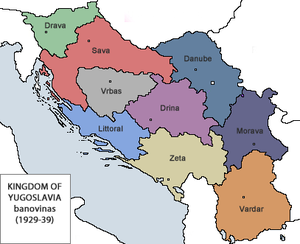
The State of Slovenes, Croats and Serbs was a political entity that was constituted in October 1918, at the end of World War I, by Slovenes, Croats and Serbs (Prečani) residing in what were the southernmost parts of the Austro-Hungarian Empire. Although internationally unrecognised, this was the first incarnation of a Yugoslav state founded on the Pan-Slavic ideology. Thirty-three days after it was proclaimed, the state joined the Kingdom of Serbia and the Kingdom of Montenegro to form the Kingdom of Serbs, Croats and Slovenes.
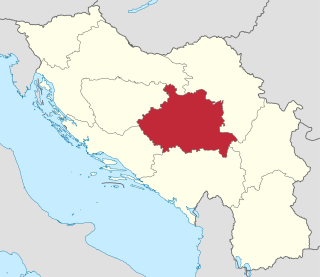
The Drina Banovina or Drina Banate was a province (banovina) of the Kingdom of Yugoslavia between 1929 and 1941. Its capital was Sarajevo and it included portions of present-day Bosnia and Herzegovina and Serbia. It was named after the Drina River and, like all Yugoslav banovinas, was intentionally not based on ethnic boundaries. As a result of the creation of the Banovina of Croatia in 1939, its territory was reduced considerably.

Danube Banovina or Danube Banate, was a banovina of the Kingdom of Yugoslavia between 1929 and 1941. This province consisted of the geographical regions of Syrmia, Bačka, Banat, Baranya, Šumadija, and Braničevo. The capital city of the Danube Banovina was Novi Sad. The province was named after the Danube River.

The Vrbas Banovina or Vrbas Banate, was a province (banovina) of the Kingdom of Yugoslavia between 1929 and 1941. It was named after the Vrbas River and consisted mostly of territory in western Bosnia with its capital at Banja Luka. Dvor district of present-day Croatia was also part of the Vrbas Banovina.

The Football Association of Yugoslavia (FSJ) was the governing body of football in Yugoslavia, based in Belgrade, with a major administrative branch in Zagreb.

The Kingdom of Croatia-Slavonia was a nominally autonomous kingdom and constitutionally defined separate political nation within the Austro-Hungarian Empire. It was created in 1868 by merging the kingdoms of Croatia and Slavonia following the Croatian–Hungarian Settlement of 1868. It was associated with the Kingdom of Hungary within the dual Austro-Hungarian state, being within the Lands of the Crown of St. Stephen, also known as Transleithania. While Croatia had been granted a wide internal autonomy with "national features", in reality, Croatian control over key issues such as tax and military issues was minimal and hampered by Hungary. It was internally officially referred to as the Triune Kingdom of Croatia, Slavonia and Dalmatia, also simply known as the Triune Kingdom, and had claims on Dalmatia, which was administrated separately by the Austrian Cisleithania. The city of Rijeka, following a disputed section in the 1868 Settlement known as the Rijeka Addendum, became a corpus separatum and was legally owned by Hungary, but administered by both Croatia and Hungary.

The Sava Banovina or Sava Banate, was a province (banovina) of the Kingdom of Yugoslavia between 1929 and 1939. It was named after the Sava River and consisted of much of the present-day Croatia. Until 1931, it also comprised White Carniola, now part of Slovenia. The capital city of the Sava Banovina was Zagreb.

The Littoral Banovina or Littoral Banate, was a province (banovina) of the Kingdom of Yugoslavia between 1929 and 1939. This province consisted of much of the Croatian region of Dalmatia and parts of present-day Bosnia and Herzegovina and was named for its coastal (maritime) location. The capital city of the Littoral Banovina was Split.

The Zeta Banovina, was a province (banovina) of the Kingdom of Yugoslavia between 1929 and 1941. This province consisted of all of present-day Montenegro as well as adjacent parts of Central Serbia, Croatia, Kosovo and Bosnia and Herzegovina. It was named after the Zeta River which also gave its name to the medieval state of Zeta that roughly corresponds to modern-day Montenegro. The capital of Banovina was Cetinje.

The Banovina of Croatia or Banate of Croatia was an administrative subdivision (banovina) of the Kingdom of Yugoslavia between 1939 and 1941. It was formed by a merger of Sava and Littoral banovinas into a single autonomous entity, with small parts of the Drina, Zeta, Vrbas and Danube banovinas also included. Its capital was Zagreb and it included most of present-day Croatia along with portions of Bosnia and Herzegovina and Serbia. Its sole Ban during this period was Ivan Šubašić.
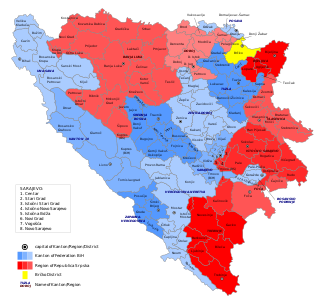
In Bosnia and Herzegovina, the smallest administrative unit is the municipality. Prior to the 1992–95 Bosnian War there were 109 municipalities in what was then Socialist Republic of Bosnia and Herzegovina. Ten of these formed the area of the capital Sarajevo.

Ban of Croatia was the title of local rulers or office holders and after 1102, viceroys of Croatia. From the earliest periods of the Croatian state, some provinces were ruled by bans as a ruler's representative (viceroy) and supreme military commander. In the 18th century, Croatian bans eventually became the chief government officials in Croatia.
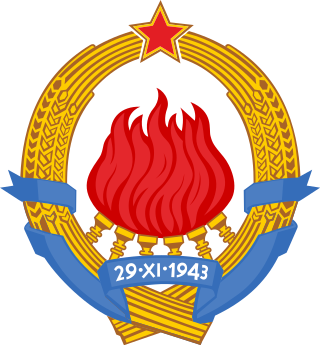
Yugoslavia had various administrative divisions throughout its 74 years of existence.

Yugoslavia was a state concept among the South Slavic intelligentsia and later popular masses from the 19th to early 20th centuries that culminated in its realization after the 1918 collapse of Austria-Hungary at the end of World War I and the formation of the Kingdom of Serbs, Croats and Slovenes. However, the kingdom was better known colloquially as Yugoslavia ; in 1929 it was formally renamed the "Kingdom of Yugoslavia".
Parliamentary elections were held in Yugoslavia on 5 May 1935. The result was a victory for the governing Yugoslav National Party (JNS), which won 303 of the 370 seats in Parliament.
The term Banate can refer to:
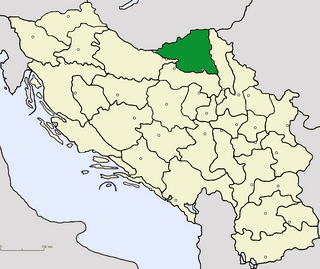
Bačka Oblast was one of the oblasts of the Kingdom of Serbs, Croats and Slovenes from 1922 to 1929. Its administrative center was Novi Sad.

Belgrade City Administration, was an administrative district of the Kingdom of Yugoslavia from 1929 to 1941. Its administrative center was Belgrade.
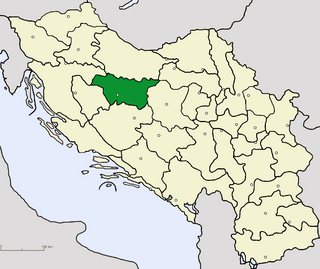
Vrbas Oblast was one of the oblasts of the Kingdom of Serbs, Croats and Slovenes from 1922 to 1929. Its capital was Banja Luka. It was named after the Vrbas River.

The Banovina Palace, colloquially known as Banovina, in Novi Sad, capital of the autonomous province of Vojvodina in Serbia, is a representative complex serving as a seat of both the Government and the Assembly of Vojvodina. The building, designed by Dragiša Brašovan, was constructed between 1935 and 1940 in modernist style for the administrative needs of the Danube Banovina.



